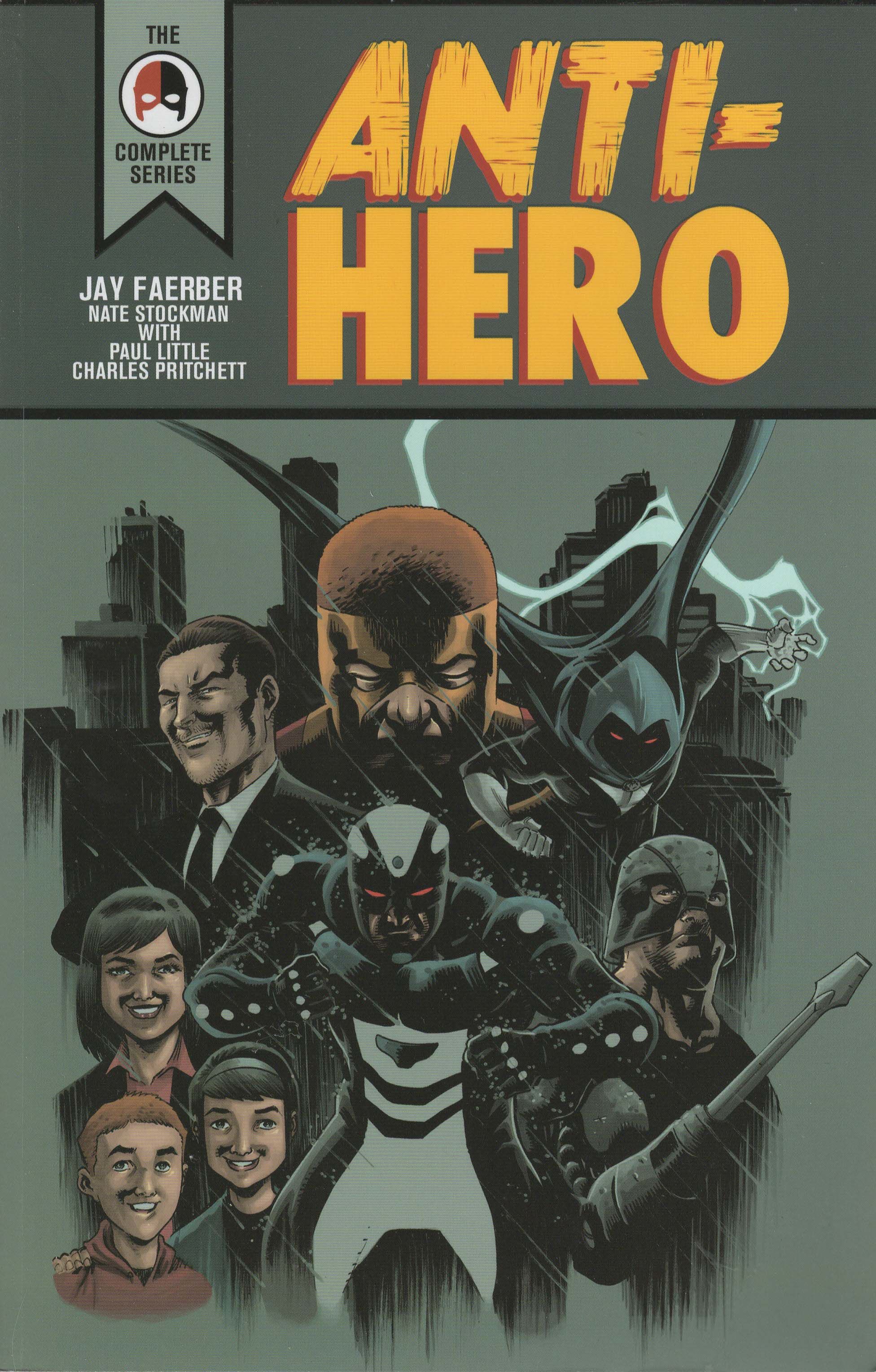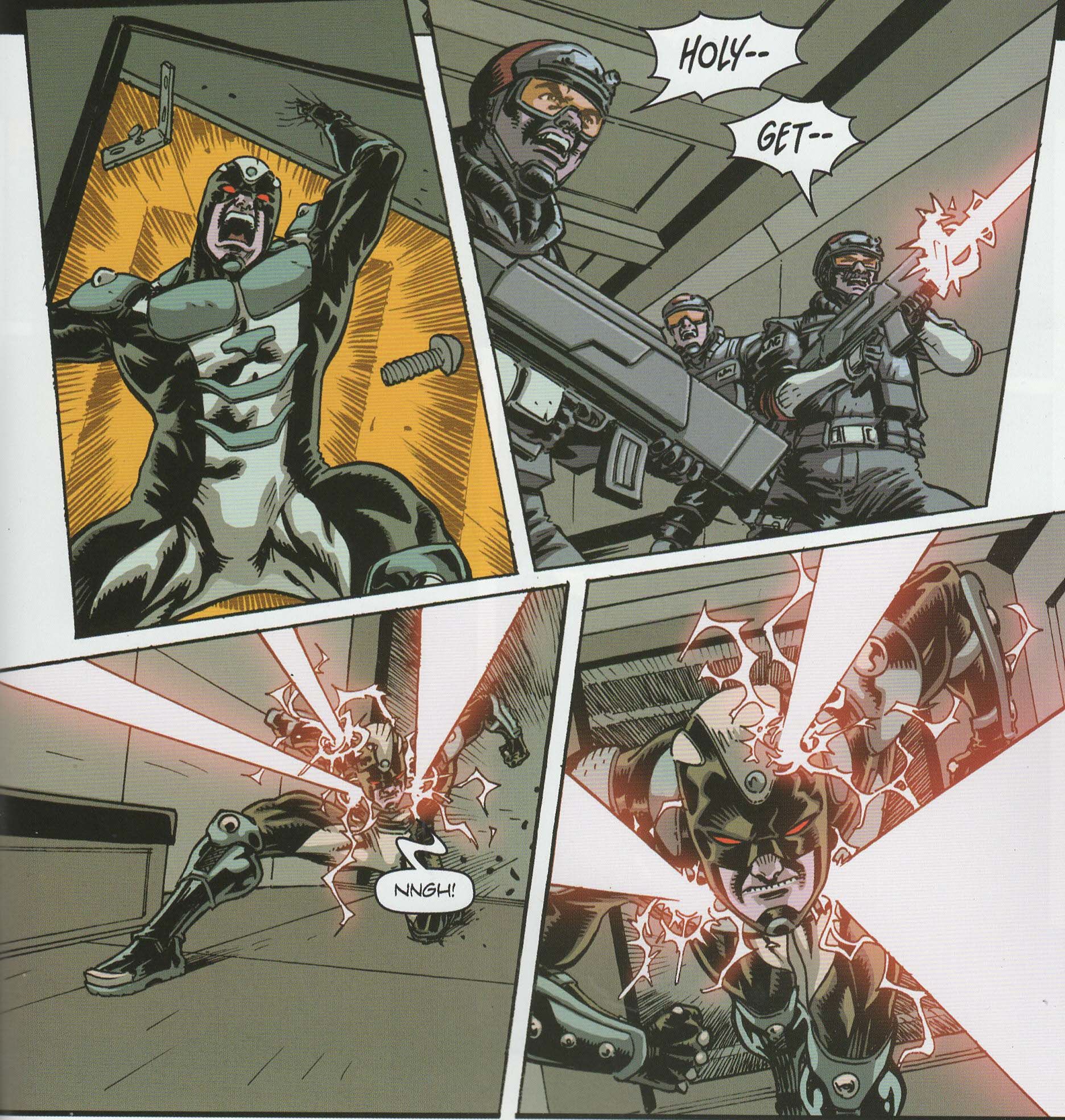"Where have all the good men gone and where are all the gods? Where's the street-wise Hercules to fight the rising odds?"
Monkeybrain Comics keeps cranking out interesting digital comics, and I keep waiting until they get published because I'm so old, so I'm glad they published Jay Faerber's latest superhero epic, Anti-Hero. Faerber, in case you haven't been keeping track of him, is probably the best superhero writer of this millennium, as he's done the excellent Noble Causes, the excellent Dynamo 5, and a few other very cool superhero stories for Image since 2001.
Anti-Hero is another example of what a good superhero writer he is, so if you're still thinking you don't like Faerber because you remember him from Generation X or Titans, you should probably check out his more recent work. Anti-Hero is drawn by Nate Stockman, colored by Paul Little, and lettered by Charles Pritchett. It's published by IDW and costs $19.99.
I reviewed the first two chapters of Anti-Hero a while back (man, almost two years ago - tempus fugit and all that), and I liked the set-up then, and I like the way the story goes now. So that's handy. Faerber, as he's working with his own characters, isn't particularly concerned if he goes certain ways with them, but he always has the ideal of a superhero being superheroic in mind, which is why when he plays off of that, things get so interesting. In many superhero comics, either they're corporate-owned so nothing too odd can happen to them (and if they do, they get retconned, which provides Our Dread Lord and Master with interesting column ideas but isn't really great storytelling) or they're by people who seem to be terribly cynical about them and want to tear them down.
Faerber likes superheroes, it seems, so he keeps them heroic even as he puts them through the wringer. It's a fine line to walk, but while Faerber's non-superhero work can be fairly cynical, even in a book like this, it never feels like he's angry toward superheroes. It's a nice attitude.
Faerber's story gets to the heart of every superhero story - the secret identity and what happens when it's compromised. Paragon is a superhero in Rainier City, while Callum Finney is a low-level hood in a criminal organization. Callum is a coward and a liar, which is why he manages to escape when Paragon thwarts his boss's latest scheme - he jumps into the river rather than help his cronies. Mr. Quinlan gives him one more chance, and Callum happens to see Paragon taking off his mask. He follows Paragon - Henry - around for a while, and then decides that Henry is going to work for him, taking over Quinlan's criminal empire. Simple, right?
Well, of course it's not, because there wouldn't be much of a book if it were. Callum has rigged things so that he has to log onto a web site every 24 hours or Henry's secret will be emailed to the world, so killing Callum is out. Henry has an ex-wife and a kid, so he's desperate to protect them. Callum's scheme seems to be working well, but Quinlan has some cards up his sleeve, too. One of the other heroes in the city, Rainshadow, get suspicious of the new "villain" in town, because that villain knew exactly how to disable him. Henry has trouble holding onto a job because of his secret identity, and unlike DC and Marvel superhero stories, it doesn't just work itself out. Henry has his own plan to get out from under Callum's thumb, but he's going to need his ex-wife's help, so he has to tell her his secret, the keeping of which helped lead to the dissolution of his marriage.
Naomi takes it all in stride and wonders why he didn't tell her sooner, and Henry tells her about the dark side of everyone knowing your secret identity - it really does lead to danger for everyone who knows. His plan to defeat Callum is a good one, but of course, it goes a bit sideways, because real life doesn't conform to everyone's plans. Faerber understands that "real life" doesn't follow a straight line, and unlike when things go wrong in more mainstream superhero comics (and they always do), there's not a lot of course-correcting here, as everyone needs to deal with the new reality when the plans go awry. And they don't always do a good job on the fly.
There's plenty of superhero action, of course, and Faerber makes everything fit together pretty well. He's assisted in this by Stockman and Little, who do fine work on the art. Stockman's art isn't classically "superheroic," but as the book is a mash-up of crime fiction with superheroes, it doesn't have to be, and Stockman gets the grittiness of crime fiction to fit in well with the more bright reality of superheroes. He does a lot of nice work with the way Henry and Callum react to each other - Henry, obviously, seethes at Callum, who tries to remain louche throughout even when his plans start to disintegrate. Stockman does a good job showing Callum with Quinlan, too, because Quinlan, despite his age, is the bad-ass Callum pretends to be, and so Callum is always backing down to him, and Stockman shows his cravenness and rage when he does quite well. The scene where Henry comes clean to Naomi is very nice, too, as she goes through all the emotions we expect, from anger to awe at his abilities. Toward the end, when Naomi is in danger, Stockman does a wonderful job showing why Henry didn't tell her about his other life, because her face is twisted in fear and pain, and no one would want to see that on the face of someone they love.
Stockman designs nice costumes, and while occasionally his action poses are a bit stiff, he draws visceral violence very well - there's not much of it at all, but when it comes, it has an impact. Little, meanwhile, makes Rainier City (which is pretty much Seattle, which is where Faerber used to live) a fairly dark and dreary place, but it's not so murky we can't see what's happening (which is a problem with some digital comics that have been moved to print). He uses nice colors on the superhero costumes - they aren't all black and depressing, but they are a bit muted, so they look a bit more like "real-life" spandex and leather. Faerber didn't really set out to make a "superhero-in-the-real-world" story, but the way Stockman and Little do the art, it becomes a bit more like that, which grounds it a bit more than if Faerber had been more obvious about it.
Anti-Hero is just a good, solid superhero story that takes unexpected twists not because they're gratuitous, but because the way things go, people need to revise their plans. Which, despite the superhero trappings, makes this a more relatable story than many tales about people with powers. It's a keen comic, and it just shows that Faerber is one of the best superhero writers working today. Luckily, he doesn't desperately need to write for the Big Two, so he can keep doing cool stuff like this. Plus, War Chest is in this comic. War Chest, in case you never read Dynamo 5, is a less subtle Power Girl. Yes, that's what I wrote. She's awesome. And Faerber gets her into this comic, which is neat to see!
Rating: ★ ★ ★ ★ ★ ★ ★ ½ ☆ ☆





